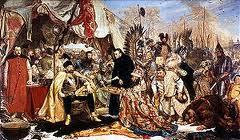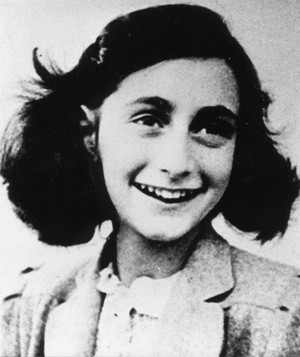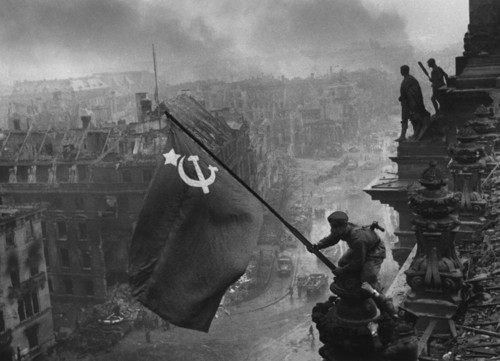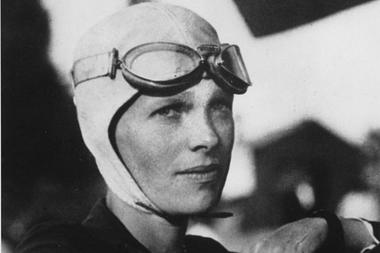Livonian War 1558-1582
Main article: Livonian War
Europe, 1550.
Ferdinand I, Holy Roman Emperor once again asked for help of Gustav I of Sweden, and The Kingdom of Poland (1385–1569) also began direct negotiations with Gustavus, but nothing resulted because on September 29, 1560, Gustavus I Vasa died. The chances for success of Magnus and his supporters looked particularly good in 1560 (and 1570). In the former case he had been recognised as their sovereign by The Bishopric of Ösel-Wiek and The Bishopric of Courland, and as their prospective ruler by the authorities of The Bishopric of Dorpat; The Bishopric of Reval with the Harrien-Wierland gentry were on his side; Livonian Order conditionally recognised his right of ownership of Estonia (Principality of Estonia). Then along with Archbishop Wilhelm von Brandenburg of The Archbishopric of Riga and his Coadjutor Christoph von Mecklenburg, Kettler gave to Magnus the portions of The Kingdom of Livonia, which he had taken possession of, but they refused to give him any more land. Once Eric XIV of Sweden became king he took quick actions to get involved in the war. He negotiated a continued peace with Muscovy and spoke to the burghers of Reval city. He offered them goods to submit to him as well as threatening them. By June 6, 1561 they submitted to him contrary to the persuasions of Kettler to the burghers. The King's brother Johan married the Polish princess Catherine Jagiellon. Wanting to obtain his own land in Livonia, he loaned Poland money and then claimed the castles they had pawned as his own instead of using them to pressure Poland. After Johan returned to Finland, Erik XIV forbade him to deal with any foreign countries without his consent. Shortly after that Erik XIV started acting quickly lost any allies he was about to obtain, either from Magnus or the Archbishop of Riga. Magnus was upset he had been tricked out of his inheritance of Holstein. After Sweden occupied Reval, Frederick II of Denmark made a treaty with Erik XIV of Sweden in August 1561. The brothers were in great disagreement and Frederick II negotiated a treaty with Ivan IV on August 7, 1562 in order to help his brother obtain more land and stall further Swedish advance. Erik XIV did not like this and The Northern Seven Years' War between The Free City of Lübeck, Denmark, Poland, and Sweden broke out. While only losing land and trade, Frederick II and Magnus were not faring well. But in 1568 Erik XIV became insane and his brother Johan III took his place. Johan III ascended to the throne of Sweden and due to his friendship with Poland he began a policy against Muscovy. He would try to obtain more land in Livonia and exercise strength over Denmark. After all parties had been financially drained, Frederick II let his ally, King Sigismund II Augustus of Polish-Lithuanian Commonwealth, know that he was ready for peace. On December 15, 1570, the Treaty of Stettin was concluded. It is, however, more difficult to estimate the scope and magnitude of the support Magnus received in Livonian cities. Compared to the Harrien-Wierland gentry, the Reval city council, and hence probably the majority of citizens, demonstrated a much more reserved attitude towards Denmark and King Magnus of Livonia. Nevertheless, there is no reason to speak about any strong pro-Swedish sentiments among the residents of Reval. The citizens who had fled to The Bishopric of Dorpat or had been deported to Muscovy hailed Magnus as their saviour until 1571. The analysis indicates that during the Livonian War a pro-independence wing emerged among the Livonian gentry and townspeople, forming the so-called "Peace Party". Dismissing hostilities, these forces perceived an agreement with Muscovy as a chance to escape the atrocities of war and avoid the division of Livonia. That is why Magnus, who represented Denmark and later struck a deal with Ivan the Terrible, proved a suitable figurehead for this faction.
The Peace Party, however, had its own armed forces – scattered bands of household troops (Hofleute) under diverse command, which only united in action in 1565 (Battle of Pärnu, 1565 and Siege of Reval, 1565), in 1570–1571 (Siege of Reval, 1570-1571; 30 weeks), and in 1574–1576 (first on Sweden’s side, then came the sale of Wiek to the Danish Crown, and the loss of the territory to the Tsardom of Russia. In 1575 after Muscovy attacked Danish claims in Livonia, Frederick II dropped out of the competition as well as the Holy Roman Emperor. After this Johan III held off on his pursuit for more land due to Muscovy obtaining lands that Sweden controlled. He used the next two years of truce to get in a better position. In 1578, he resumed the fight for not only Livonia, but also everywhere due to an understanding he made with Rzeczpospolita. In 1578 Magnus retired to Rzeczpospolita and his brother all but gave up the land in Livonia.
Main article: Livonian War
Europe, 1550.
Ferdinand I, Holy Roman Emperor once again asked for help of Gustav I of Sweden, and The Kingdom of Poland (1385–1569) also began direct negotiations with Gustavus, but nothing resulted because on September 29, 1560, Gustavus I Vasa died. The chances for success of Magnus and his supporters looked particularly good in 1560 (and 1570). In the former case he had been recognised as their sovereign by The Bishopric of Ösel-Wiek and The Bishopric of Courland, and as their prospective ruler by the authorities of The Bishopric of Dorpat; The Bishopric of Reval with the Harrien-Wierland gentry were on his side; Livonian Order conditionally recognised his right of ownership of Estonia (Principality of Estonia). Then along with Archbishop Wilhelm von Brandenburg of The Archbishopric of Riga and his Coadjutor Christoph von Mecklenburg, Kettler gave to Magnus the portions of The Kingdom of Livonia, which he had taken possession of, but they refused to give him any more land. Once Eric XIV of Sweden became king he took quick actions to get involved in the war. He negotiated a continued peace with Muscovy and spoke to the burghers of Reval city. He offered them goods to submit to him as well as threatening them. By June 6, 1561 they submitted to him contrary to the persuasions of Kettler to the burghers. The King's brother Johan married the Polish princess Catherine Jagiellon. Wanting to obtain his own land in Livonia, he loaned Poland money and then claimed the castles they had pawned as his own instead of using them to pressure Poland. After Johan returned to Finland, Erik XIV forbade him to deal with any foreign countries without his consent. Shortly after that Erik XIV started acting quickly lost any allies he was about to obtain, either from Magnus or the Archbishop of Riga. Magnus was upset he had been tricked out of his inheritance of Holstein. After Sweden occupied Reval, Frederick II of Denmark made a treaty with Erik XIV of Sweden in August 1561. The brothers were in great disagreement and Frederick II negotiated a treaty with Ivan IV on August 7, 1562 in order to help his brother obtain more land and stall further Swedish advance. Erik XIV did not like this and The Northern Seven Years' War between The Free City of Lübeck, Denmark, Poland, and Sweden broke out. While only losing land and trade, Frederick II and Magnus were not faring well. But in 1568 Erik XIV became insane and his brother Johan III took his place. Johan III ascended to the throne of Sweden and due to his friendship with Poland he began a policy against Muscovy. He would try to obtain more land in Livonia and exercise strength over Denmark. After all parties had been financially drained, Frederick II let his ally, King Sigismund II Augustus of Polish-Lithuanian Commonwealth, know that he was ready for peace. On December 15, 1570, the Treaty of Stettin was concluded. It is, however, more difficult to estimate the scope and magnitude of the support Magnus received in Livonian cities. Compared to the Harrien-Wierland gentry, the Reval city council, and hence probably the majority of citizens, demonstrated a much more reserved attitude towards Denmark and King Magnus of Livonia. Nevertheless, there is no reason to speak about any strong pro-Swedish sentiments among the residents of Reval. The citizens who had fled to The Bishopric of Dorpat or had been deported to Muscovy hailed Magnus as their saviour until 1571. The analysis indicates that during the Livonian War a pro-independence wing emerged among the Livonian gentry and townspeople, forming the so-called "Peace Party". Dismissing hostilities, these forces perceived an agreement with Muscovy as a chance to escape the atrocities of war and avoid the division of Livonia. That is why Magnus, who represented Denmark and later struck a deal with Ivan the Terrible, proved a suitable figurehead for this faction.
The Peace Party, however, had its own armed forces – scattered bands of household troops (Hofleute) under diverse command, which only united in action in 1565 (Battle of Pärnu, 1565 and Siege of Reval, 1565), in 1570–1571 (Siege of Reval, 1570-1571; 30 weeks), and in 1574–1576 (first on Sweden’s side, then came the sale of Wiek to the Danish Crown, and the loss of the territory to the Tsardom of Russia. In 1575 after Muscovy attacked Danish claims in Livonia, Frederick II dropped out of the competition as well as the Holy Roman Emperor. After this Johan III held off on his pursuit for more land due to Muscovy obtaining lands that Sweden controlled. He used the next two years of truce to get in a better position. In 1578, he resumed the fight for not only Livonia, but also everywhere due to an understanding he made with Rzeczpospolita. In 1578 Magnus retired to Rzeczpospolita and his brother all but gave up the land in Livonia.























